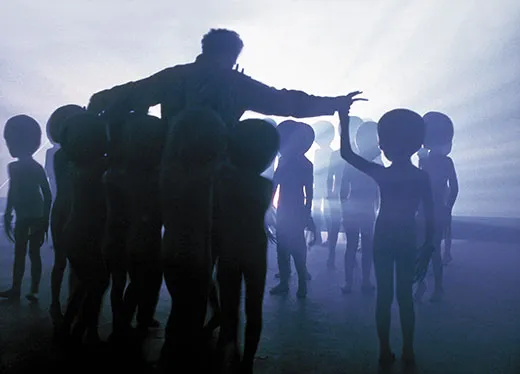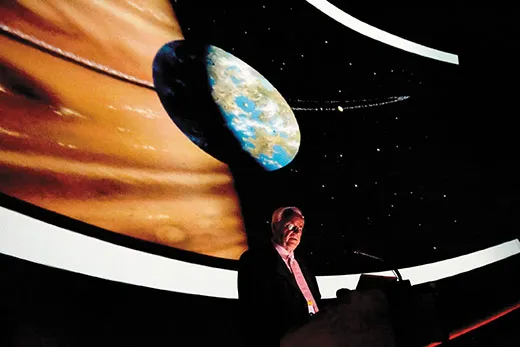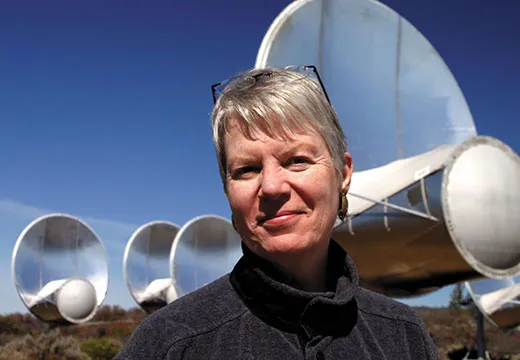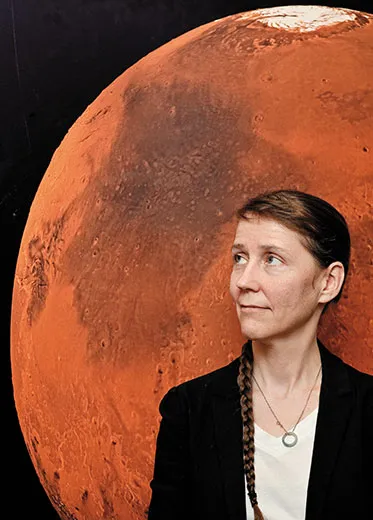Ready for Contact
Humans have searched for extraterrestrial life for more than a century. What will we do when we find it?
/https://tf-cmsv2-smithsonianmag-media.s3.amazonaws.com/filer/Alien-Contact-Close-Encounters-of-the-Third-Kind-631.jpg)
As far as we know, we are alone in the universe. Earth is the only planet known to be inhabited by life, and humans are the only intelligent beings.
There are, of course, rumors of alien contacts. There's Area 51, the Air Force base in Nevada, where the government supposedly stores aliens in freezers. And there was that mysterious crash landing in Roswell, New Mexico, in 1947—and mutilated cows in Colorado. In a recent poll, one in four Americans said they believed the planet has already been visited by an extraterrestrial. For the rest of us, though, aliens are relegated to the realm of fiction, and UFO sightings are simply hoaxes or events that have some unknown but natural explanation.
That doesn't mean alien life couldn't be real. Scientists are taking that possibility seriously and are looking beyond our planet for evidence of extraterrestrials. "Long ago people suspected that there might be life in other places," says Mary Voytek, NASA's head astrobiologist. "I think it's a fundamental question everyone has: Are we unique?"
What happens if the answer to that question is no? What if we finally discover we're not alone? Believe it or not, there is a plan.
The idea there might be other creatures in the universe has been around since at least the fifth century B.C., when the Greek philosopher Democritus posited "innumerable worlds of different sizes," not all of which were devoid of life. Four hundred years later, the Roman poet Titus Lucretius Carus wrote of "other worlds" with "different tribes of men, kinds of wild beasts."
In the 17th century, German astronomer Johannes Kepler, in what is regarded as the first science fiction story, wrote about a voyage to the Moon in which travelers encountered reptile-like creatures. At the end of that century, Dutch mathematician Christiaan Huygens wrote a book speculating on the conditions on other planets and concluding that some of them must harbor life.
Aiming his telescope at Mars in 1894, the American astronomer Percival Lowell saw a web of what he thought were canals—structures so elaborate they could have been built only by beings with intelligence.
With the founding of NASA and other space agencies in the 20th century, people began to explore the solar system and actively search for alien life. We sent satellites to photograph other planets and robots to explore their surfaces. Astronauts walked on the Moon and brought back rocks and dust. Scientists found evidence of water on the Moon and Mars, as well as on Jupiter's moon Europa. Amino acids were discovered in meteorites that had fallen to Earth. Ever more powerful telescopes and new ways to analyze their readings have led to the discovery of hundreds of planets orbiting other stars. Though no one has found life anywhere other than on Earth, that discovery seems just around the corner.
The search for extraterrestrials takes two broad forms. NASA and other government-funded space agencies are concentrating their search on simple, microscopic life that may have existed—or may still exist—close to home, on a planet or moon in our solar system. Other scientists search for signs of creatures a bit more like us—beings that may themselves be searching for other intelligent life-forms.
The most ambitious search began in 1960, when astronomer Frank Drake pointed a radio telescope at two stars similar to our sun and listened for some kind of "signature of intelligence." He tuned in to a frequency of 1,420 megahertz, which is the radio wave emitted by cold hydrogen gas, chosen because of hydrogen's abundance in the universe. At the time it was the best guess of the mutually intelligible signal an alien race might use to contact Earth.
Drake's work inspired people around the world to search for extraterrestrial intelligence. The foremost project, called the Search for Extra-Terrestrial Intelligence (SETI), is based in Mountain View, California. SETI has never found definitive evidence of intelligent life, but in 1977 an engineer working at a telescope in Ohio detected a mysterious 72-second pulse that originated a long way from Earth. Whether it came from aliens or, more likely, a black hole event was never determined. The rather long pulse—which prompted the engineer to write "Wow!" in the margin of a printout of the telescope's recordings—has not been repeated, but it has persuaded at least some radio astronomers to keep searching.
More recently, SETI scientists expanded their search beyond radio frequencies. "We're looking for bright flashes that last a billionth of a second or less," says Jill Tarter, director of the Center for SETI Research and the inspiration for the Jodie Foster character in the movie Contact. "As far as we know, this is something that a laser can do but that nature can't." SETI scientists figure that such a pulse would represent an intentional, high-tech, long-distance message: "evidence of somebody deliberately using a laser focused into a large telescope to create a detectable signal over the many light-years between stars," Tarter says.
The radio signal approach hasn't turned up much so far, and Tarter admits she doesn't know what the ideal frequencies might be. Even with the new search for laser flashes, the SETI scientists might be using incorrect technologies, but they still think the effort is worthwhile. As her colleague Seth Shostak says, "Columbus didn't wait for a 747 to get him across the Atlantic."
And though SETI scientists have yet to find evidence of extraterrestrials, they are well prepared for success. "Yes, we do have a plan," Tarter says. "It starts with champagne."
The plan comes from a document known as the "Declaration of Principles Concerning the Conduct of the Search for Extraterrestrial Intelligence," which grew out of plans spawned in the years when NASA had an office dedicated to SETI research, before Congress cut off funding in 1993. The first step, according to the protocol, is verifying the find through independent confirmation by another observatory using different equipment and software. "We're a very attractive target for hoaxes," Tarter says. If the signal passes this first test—which could take days—and is confirmed, the SETI scientists would notify the secretary general of the United Nations. The scientists would also alert the international astronomy community by e-mails to members of the International Astronomical Union. And they would tell the public, probably by holding a press conference to announce the discovery to the world.
Our first contact with alien life, though, probably won't be with an intelligent, signal-beaming species. The most accessible source of potential non-Earthling life is Mars. NASA and its European counterparts are weighing options for a mission, at least 15 or 20 years from now, that would gather samples from the planet and return them to Earth.
A draft document states that any such samples would be treated with the same precautions as the Ebola virus, at least until they were deemed safe. But scientists must first develop a plan to protect this planet from anything they might find. "It would be really stupid to bring something back and then not know how to kill it if it was trying to eat us," says Catharine Conley, whose title is NASA's Planetary Protection Officer. (Conley says she has only the second-coolest title in NASA history; there once was a "Director, Universe.")
Conley envisions a scenario in which the research on potential alien life is conducted in front of cameras hooked up to the Internet. "The expectation is that none of this will be done in secrecy," she says. "We want people to be interested." That's probably not going to be a problem. It "would be a discovery equivalent to those made by some of the great names in history," says John Billingham, former head of NASA's SETI program.
And how would the world react to a discovery announcement? "Your guess is as good as mine," Tarter says.
Paul Davies, an astrobiologist at Arizona State University, heads up the SETI Post-Detection Taskgroup, a collection of scientists, journalists, lawyers, science fiction writers and philosophers. Their job is to advise relevant parties—other scientists, governments, the United Nations—about what to do if a SETI signal or any "putative evidence of extraterrestrial intelligence" were detected. While waiting for a contact, the group deliberates about what the consequences might be. While a discovery of microscopic life on another body in our solar system would be "of profound significance, which would change our worldview," Davies says, "it's not one of these things that is going to be disruptive to society." But the discovery of a signal from intelligent extraterrestrials could lead to "mayhem." Billingham agrees. "Some people will think that this is a natural event in the continuing work on scientific questions," he says, and others will ask, in panic, "What do we do now?"
People would likely fall into two camps. Catastrophists, as one of the camps is called, might well predict the end of humanity as we know it, or at least the end of our current culture. In 2010 Stephen Hawking said that making contact with aliens would be "a little too risky" and compared the event to Columbus arriving in the New World, "which didn't turn out very well for the Native Americans." But millenarian enthusiasts anticipate revelations of rapture: how to cure cancer, solve the energy crisis or win world peace. And if aliens did manage to come to Earth, says Tarter, an admitted enthusiast, "they would likely have outgrown the aggressiveness that has served us so well."
As for a supersecretive government agency or powerful corporation keeping a discovery of alien life a secret, Davies thinks that's unlikely. "I think there's a big misconception in the public that somehow this is all a cloak-and-dagger operation, and it's not," he says. "People are quite open about what they are doing."
Sarah Zielinski is an assistant editor at Smithsonian. She writes the "Surprising Science" blog on Smithsonian.com.
/https://tf-cmsv2-smithsonianmag-media.s3.amazonaws.com/accounts/headshot/Sarah-Zielinski-240.jpg)





/https://tf-cmsv2-smithsonianmag-media.s3.amazonaws.com/accounts/headshot/Sarah-Zielinski-240.jpg)